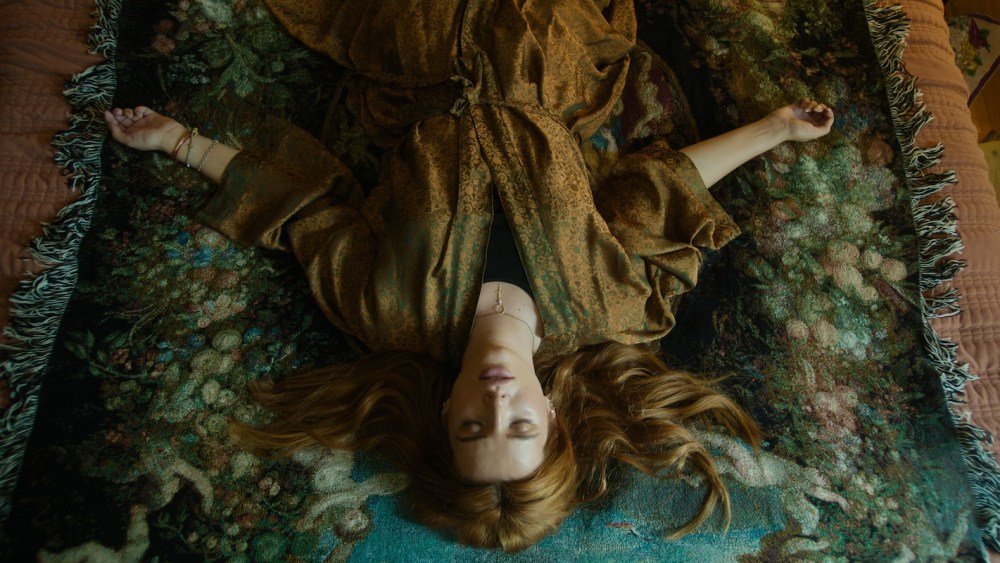Mitzi Peirone’s 2018 first feature “Braid” was a series of kinky dress-up games posing as a thriller, one that valued style over substance to such a point that there was almost nothing solid for a viewer to hang onto. Her sophomore effort, “Saint Clare,” takes a step in the right direction, with Guinevere Turner onboard as co-writer in adapting Don Roff’s 2021 novel “Clare at Sixteen.” That injects a greater degree of narrative spine to this vehicle for Bella Thorne as a young woman in a small town uniquely equipped to deal with a plague of possibly lethal disappearances — she is a sort of serial killer herself, albeit one who only preys upon predators.
The book (which commenced an ongoing series) has been described as a “delightfully dark teen horror comedy” reminiscent of “Heathers.” Peirone’s film doesn’t hit that tonal mark, however, aiming instead for an unsteady combination of quasi-slasher, fever dream, youth rom-com, investigative mystery and revenge fantasy. Again, the aesthetics seem more fussed over than the suspense mechanics or character definition. But those looking for a cool-looking mix of grrl power and genre tropes may find this indie production diverting enough.
Introduced repeating a mantra purportedly spoken by Joan of Arc (“Everything I’ve said and done has been in the hands of God. I was born to do this. I am not afraid.”), Thorne’s Clare Bleecker is a conflicted hot mess who’s just moved for the nth time since losing her parents years before. Upgraded from teen to collegian to suit the actress cast, she’s now living with grandmother Gigi (Rebecca De Mornay) and attending university classes in leafy Pickman Flats. But its woods only serve to remind her of a childhood incident in which she single-handedly saved peer campers from a random maniac. Since then, she’s similarly served cold justice to other perps, including a leering goon (Bart Johnson) who finagles her into a “ride home” from a bus stop for obvious nefarious purposes. His premature demise, however, does not stop more young women from going missing, as they have hereabouts for three decades.
Though equally tormented and compelled by her victimizer-victimizing mission, Clare is soon sniffing out questionable behavior among her classmates. They include Drama Dept. princess Amity (Erica Dasher), her ex-boyfriend Wade (Dylan Flashner), study partner Juliana (Joy Rovaris) and campus photographer Truman (Jan Luis Castellanos). Meanwhile Clare’s own poorly-alibi’d hours spent sleuthing and snuffing bad guys also attract suspicion, notably from grandma and police Detective Timmons (Ryan Philippe).
Add to the above possible sex trafficking, flashbacks, dreams, a friendly comedic ghost (Frank Whaley) no one but Clare can see and the school’s cross-dress production of Ira Levin’s “Deathtrap” (with Joel Michaely as a gratingly old-school “screaming queen” stage director), and there are more than enough plot elements here to chart. The trouble is, Peirone doesn’t seem much interested in mapping out any cogent storytelling path. She’s more drawn to trying out different visual strategies, treating sequences as stand-alone setpieces divided by blackouts, rather than building any cumulative intrigue or tension. The result is stimulating but close to arbitrary, with too many flashy montages and a giallo-like paucity of internal logic.
That lack of focus extends to Clare herself: The film never quite decides whether it wants to present her as caustically confident, PTSD-riddled, an avenging superheroine or delusionally dangerous. Thorne carries the movie, albeit more as a glam, mercurial star turn than a fully-rounded character. When Clare is meant to be suffering a meltdown, her histrionics needn’t rise from a palpable psychological space — what’s important is that the camera and editing seize the hyperactive moment. Other things just get lost in the clutter, like the “why” of Grandma Gigi’s edginess, sporadic Catholic religious imagery or Whaley’s vanishing from a good chunk of the runtime. Variably arch and pretentious notes in the dialogue do zilch to help clarify such matters.
Still, the penchant for flamboyant visual and audio gambits keeps “Saint Clare” lively in textural terms, even if after a while it hardly seems to matter who’s doing what terrible thing to whom. While they don’t really heighten tension, the hot colors and crazy angles in Luka Bazeli’s cinematography, as well as Zola Jesus’ pulsating electronic score, all contribute to a sense that this is an assertive directorial vision — though arguably Peirone has yet to pen or find material that will ideally serve her sometimes over-busy style.
You might think a story about a possibly schizophrenic heroine would provide that fit. But despite a stronger premise this time, “Clare” echoes the filmmaker’s prior feature in remaining on a highly worked surface — one that doesn’t illuminate people and events so much as treats them like decorative pawns in a game whose rules, as well as its casualties, ultimately feel inconsequential.
“Saint Clare” will be released in U.S. theaters, on demand and via digital platforms on July 18.
















Leave a Reply